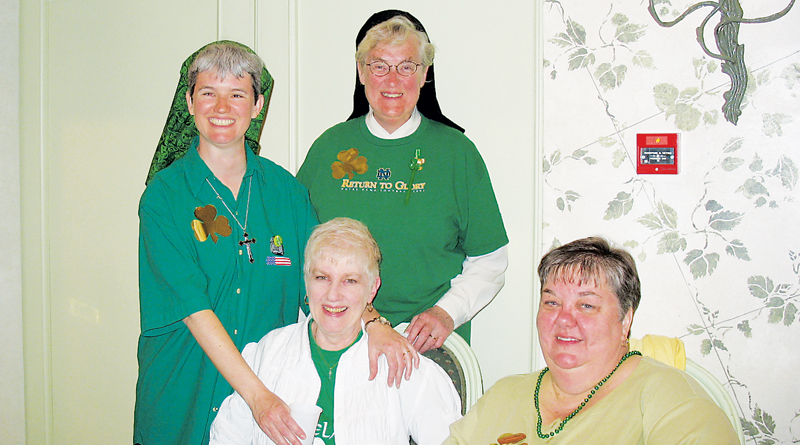PATRICK WAS A SAINT, BUT I AIN’T

Most folks generally know that St. Patrick is a saint of the Catholic Church, and that his feast day is observed on March 17 (the day he died). And many may have heard about what made him a saint in the eyes of the Church: he converted the pagans of Ireland to Christianity, drove the snakes out of Ireland and used the shamrock to preach about the Holy Trinity.
For most, however, St. Patrick’s Day is an occasion for adults to drink green beer and eat corned beef and cabbage. Around the world, in fact, millions of pints of beer are consumed on St. Patrick’s Day, amounting to more than $245 million! Guinness sales also soar on St. Patrick’s Day. Recent figures show that 5.5 million pints of the black stuff are downed around the world every day. But on St. Patrick’s Day that figure is doubled. As you sip an emerald brew, here’s some little-known facts about St. Patrick you can use to amaze your friends:
- St. Patrick wasn’t Irish. He was British, born in 385 A.D. to Roman parents in Scotland or Wales (scholars cannot agree on which).
- He was born “Maewyn Succat” but changed his name to “Patricius” after becoming a priest. If he hadn’t, we’d be wishing everyone “Happy St. Maewyn Day” on March 17.
- St. Patrick was a slave. At age16, he was kidnapped by Irish raiders and sold as a slave. He spent several years in Ireland herding sheep and learning about the people there. At age 22, he managed to escape to England where he spent 12 years studying religion in a monastery.
- According to the fossil record, Ireland never has been home to snakes as it was too cold to host amphibians during the Ice Age. Scholars suggest the term “snakes” may be figurative and refer to pagan religious beliefs and practices rather than reptiles
- The shamrock is not the symbol of Ireland. As early as the medieval period, the harp appeared on Irish gravestones and manuscripts.
- The original color associated with St. Patrick is blue, not green. In several artworks depicting the saint, he’s shown wearing blue vestments. Green was associated with the country later. Presumably because of the greenness of the countryside, Ireland is known as the “Emerald Isle.”
- There are more Irish in the USA than Ireland. An estimated 34 million Americans have Irish ancestry. Some are pure-blooded Irish, but many more have mixed ancestry. By contrast, there are 4.2 million people living in Ireland. This peculiarity has a lot to do with the troubled history of Ireland. Nevertheless, St. Patrick’s Day is the one day a year when everyone is a little bit Irish.
- St. Patrick’s was a dry holiday in Ireland until 1970. In 1903, Irish law declared St. Patrick’s Day a religious observance for the entire country meaning all pubs were shut down for the day. That meant no beer, not even the green kind, for public celebrants. The law was overturned in 1970 when St. Patrick’s was reclassified as a national holiday — allowing the taps to flow freely once again.
- There isn’t any corn in the traditional meal of corned beef and cabbage. The name is a reference to the large grains of salt historically used to cure meats, which also were known as “corns.”
- I have some treasured memories of St. Patrick’s Days. Firstly, I attended the University of Notre Dame, where there’s association with “Irish, leprechauns, shamrocks and green” 365 days a year.
While I was at Notre Dame, “The Band of the Fighting Irish” was invited to march in the Chicago St. Patrick’s Day Parade. The Plumbers Local 110 dyes the Chicago River Kelly green, which lasts for around five hours, just enough time to hold the parade downtown. Due to some delays, the Band got separated from units ahead, made a wrong turn and ended up on a dead-end street — with an Irish pub nearby. Let’s just say we made the day for some Irish revelers in the bar. One of them, in fact, offered to pay to send the then 120-piece marching band to Ireland.
In 2006, Marty and I were privileged to go on a pilgrimage to Italy. Our last night in Rome was on St. Patrick’s Day, so we celebrated the occasion with song, merriment and Italian beer. The hotel allowed us to party in a rooftop lounge with a view of the Vatican. It was the first time anyone in our group ever witnessed the religious sisters traveling with us wearing green veils and green-accessorized Franciscan habits.
“May the blessings and love of St. Patrick fall on yourself, on your home, on your dear ones and all.”
- A July 4th Mystery Or Strange Coincidence? - July 5, 2024
- What Is Flag Day All About? - June 7, 2024
- ‘Mayday!’ & May Day - May 10, 2024


